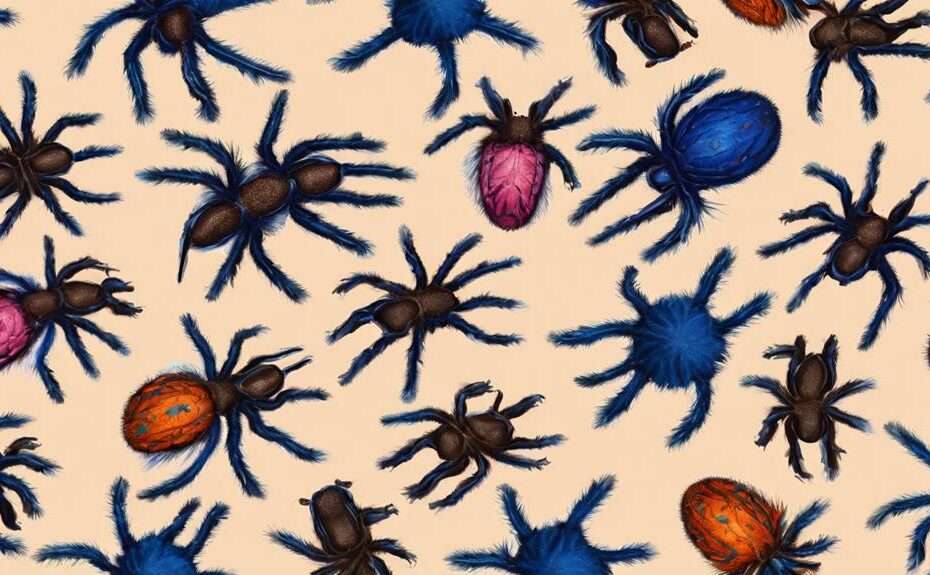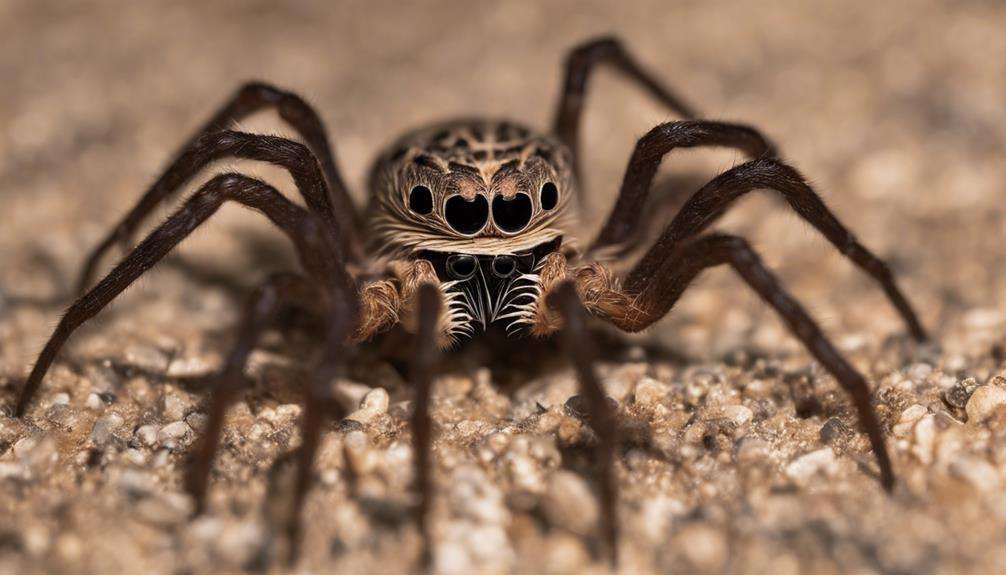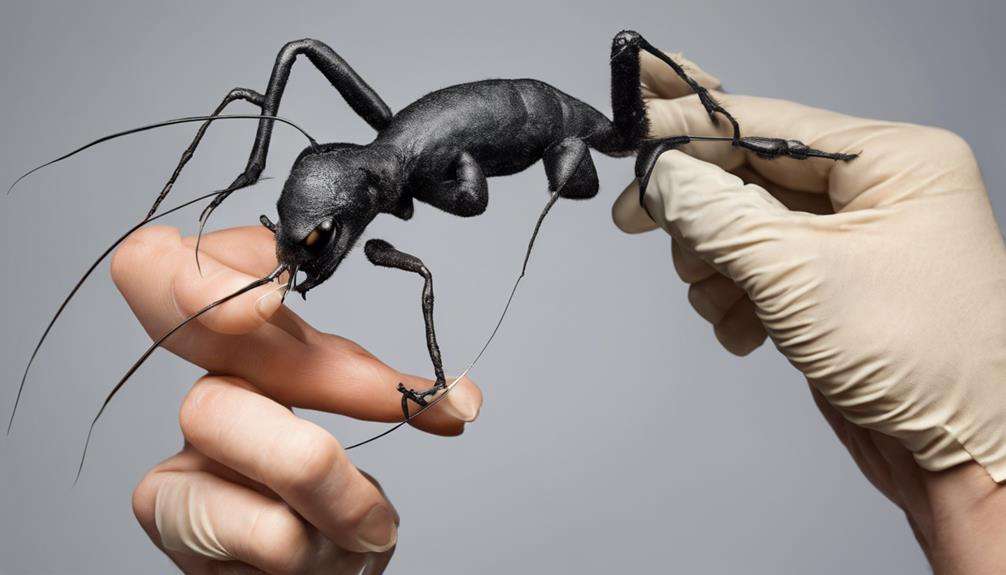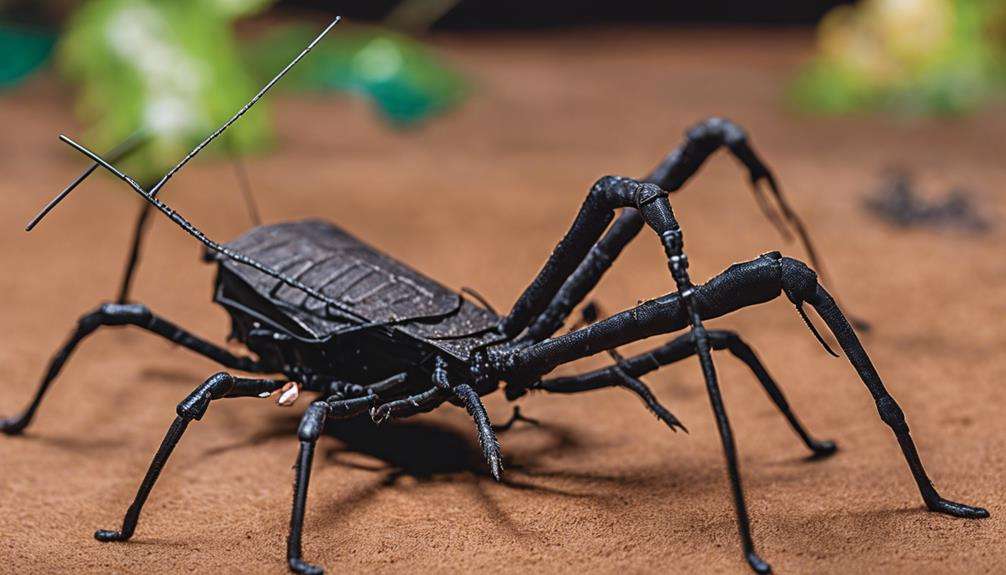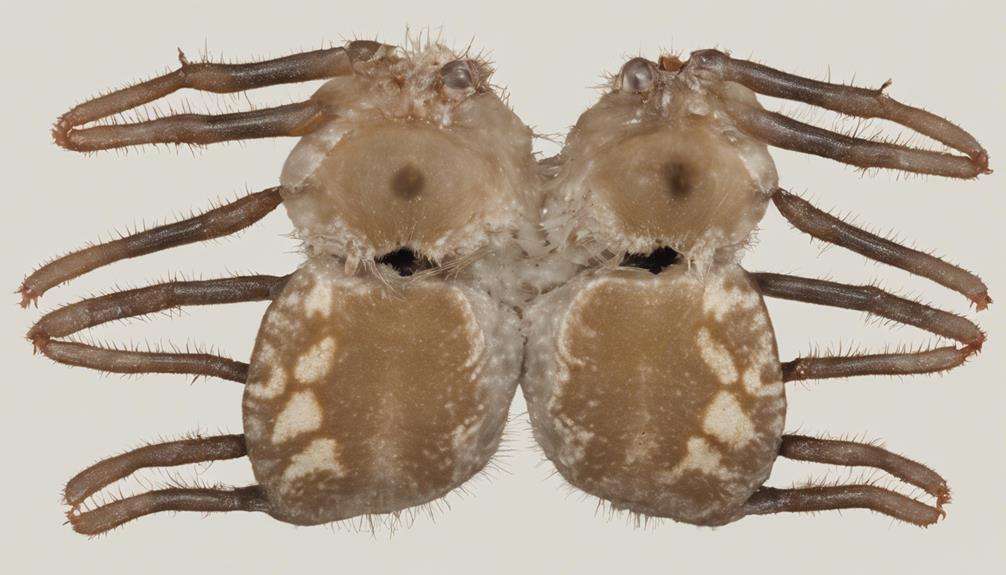If you're considering adding an exotic pet tarantula to your collection, exploring the variety of species available is akin to uncovering a treasure trove of diversity. From vibrant hues to intricate patterns, each species brings its own unique charm.
But beyond their aesthetics, these creatures hold secrets within their behaviors and biology that are waiting to be discovered. The world of exotic pet tarantulas is not just about acquiring a fascinating arachnid; it's about embarking on a journey of fascination and learning that goes beyond the surface.
Key Takeaways
- Rare color varieties like Gooty Sapphire and Cobalt Blue Tarantulas offer unique visual appeal.
- Tarantulas exhibit diverse behaviors, from docile Pink Toe to burrowing Green Bottle Blue.
- Care guidelines including temperature, humidity, feeding, substrate, and monitoring ensure well-being.
- Explore exotic options like Goliath Bird Eating and Socotra Island Blue Baboon Tarantulas for unique pet experiences.
Rare Blue Tarantula Breeds
Among the exotic pet tarantula species available for purchase, the Rare Blue Tarantula Breeds stand out for their vibrant colors and unique patterns. One fascinating blue tarantula breed is the Blue Dwarf Tarantula. Despite its small size, this tarantula species captivates with its stunning blue hues. The Blue Dwarf Tarantula is known for its metallic blue exoskeleton, which shimmers in the light, making it a true gem in the world of tarantulas. Its diminutive size adds to its charm, making it a popular choice among collectors looking to add a touch of blue elegance to their tarantula collection.
In addition to the Blue Dwarf Tarantula, other notable rare blue tarantula breeds include the Gooty Sapphire Ornamental Tarantula and the Cobalt Blue Tarantula. The Gooty Sapphire Ornamental Tarantula boasts intricate patterns and a vibrant blue color that's truly mesmerizing. On the other hand, the Cobalt Blue Tarantula showcases a unique metallic blue hue that sets it apart from other tarantula species. These rare blue tarantula breeds are highly coveted for their striking appearance and are sure to impress any tarantula enthusiast looking for something extraordinary.
Uncommon Pink Tarantula Varieties
Uncommon pink tarantula varieties, such as the Antilles Pinktoe Tarantula, exhibit striking coloration and distinctive characteristics. These pink tarantulas are known for their beautiful pink hues and docile nature. Here are some key points about these fascinating creatures:
- Vibrant Coloration: The Antilles Pinktoe Tarantula stands out with its vibrant pink color, making it a visually stunning addition to any collection.
- Docile Temperament: Despite their striking appearance, Pink Toe Tarantulas are generally known for their calm and docile behavior, making them suitable for handling by experienced keepers.
- Arboreal Habitat: Pink Toe Tarantulas are arboreal species, meaning they require tall enclosures with plenty of vertical space for climbing and web-building activities.
- Unique Beauty: With their unique pink color and arboreal lifestyle, these uncommon tarantula varieties offer a captivating mix of beauty and behavior that's sure to intrigue any tarantula enthusiast.
Exotic Green Tarantula Species
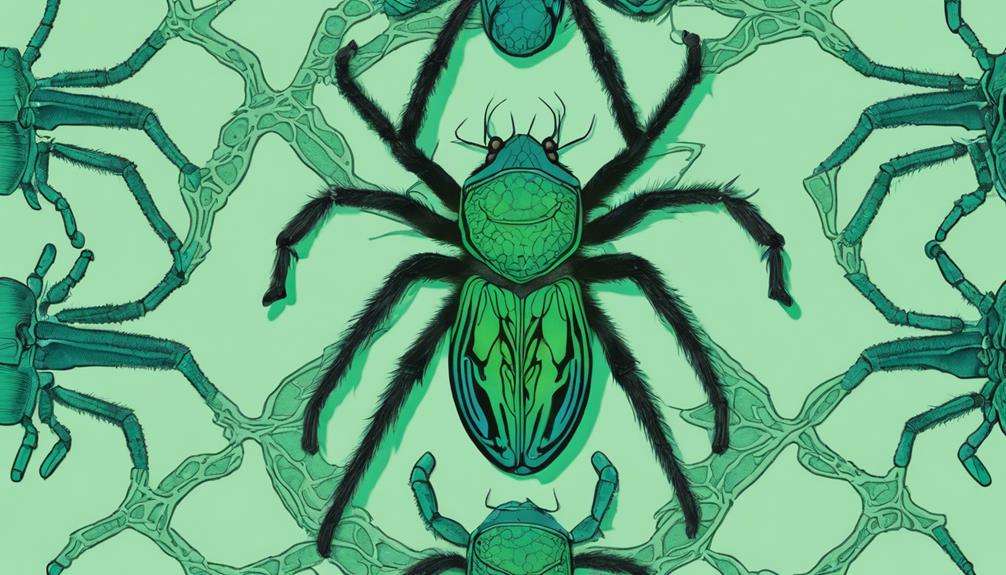
The Green Bottle Blue Tarantula, known for its striking metallic green and blue coloration, is a captivating exotic species that intrigues enthusiasts with its vibrant appearance and unique behaviors. This tarantula species, scientifically named Chromatopelma cyaneopubescens, hails from Venezuela, specifically the Paraguaná Peninsula. Its vivid colors make it a sought-after addition to tarantula collections. Green tarantulas, like the Green Bottle Blue, are favored among pet owners for their relatively docile nature and ease of care.
These tarantulas are known for their interesting behaviors, such as creating intricate burrows and web decorations. Their striking appearance and manageable care requirements make them an attractive choice for both beginner and experienced tarantula enthusiasts. In addition to the Green Bottle Blue, another notable green tarantula species is the Blue Baboon Tarantula, which also boasts unique characteristics that contribute to the diversity of exotic green tarantulas available in the pet trade market.
Unique Purple Tarantula Options
Purple tarantula species, such as the Avicularia purpurea, offer enthusiasts the opportunity to add a stunning pop of color to their collections with their vibrant purple hues. These unique purple tarantulas are a captivating choice for those looking to diversify their collection. Here are four reasons why the Avicularia purpurea stands out among other tarantula species:
- Aesthetic Appeal: The pinkish-purple coloration of the Avicularia purpurea is truly mesmerizing, making them a visually striking addition to any collection.
- Arboreal Habitat: These tarantulas are arboreal, meaning they require tall enclosures with plenty of vertical space for climbing and web-building activities.
- Docile Nature: Purple tarantulas, including the Avicularia purpurea, are known for their calm and docile temperament, making them easier to handle compared to some other tarantula species.
- Unique Coloration: The vibrant purple hues of the Avicularia purpurea set them apart from more common tarantula colors, offering a unique and eye-catching option for enthusiasts seeking something different.
Lesser-Known Yellow Tarantulas
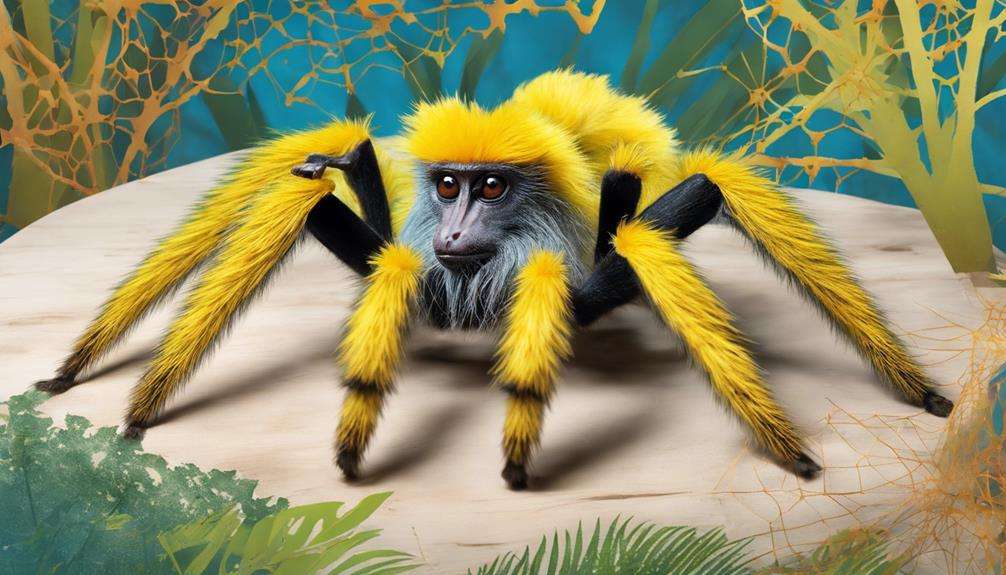
Yellow tarantulas, such as the Antilles Pinktoe Tarantula and the Brazilian Giant Blonde Tarantula, showcase unique coloration and patterns that distinguish them in the realm of exotic pets. Among these lesser-known yellow tarantulas, the Antilles Pinktoe Tarantula, or Avicularia versicolor, is particularly captivating. This species displays vibrant yellow and pink hues on its body, creating a stunning visual appeal for enthusiasts. In contrast, the Brazilian Giant Blonde Tarantula, scientifically named Nhandu chromatus, features a striking yellow coloration with contrasting dark markings, giving it a regal appearance. Both species are known for their docile nature, making them suitable for beginner tarantula keepers.
One notable species within this category is the Golden Knee tarantula, scientifically classified as Grammostola pulchripes. This tarantula species is recognized for its golden-colored legs and distinctively patterned abdomen, making it a popular choice among tarantula enthusiasts. The Golden Knee tarantula's calm temperament and striking appearance contribute to its appeal as an exotic pet option.
Special Black Tarantula Collection
Explore the allure of rare black tarantulas in the Special Black Tarantula Collection. These tarantulas showcase unique species with striking black coloration, such as the Black Velvet and Black Beauty Tarantulas.
Gain insights into proper care guidelines for these fascinating arachnids to ensure their well-being in your collection.
Rare Black Tarantulas
The Rare Black Tarantula Collection presents a selection of unique and uncommon black tarantula species highly prized for their striking coloration and allure in the exotic pet trade. These tarantulas, such as the Black Velvet Tarantula, are fascinating creatures that captivate enthusiasts worldwide. Here are some reasons why these rare black tarantulas are so highly coveted:
- Their deep black coloration exudes elegance and mystery.
- The intricate patterns on their bodies make them visually stunning.
- Black tarantulas possess a certain charm that sets them apart from other species.
- Owning one of these rare black tarantulas adds a touch of exclusivity to your collection.
These creatures aren't only beautiful but also hold a special appeal for those who appreciate the unique and extraordinary in the world of exotic pets.
Featured Tarantula Species
Featuring a selection of exotic tarantula species renowned for their distinctive coloration and fascinating behaviors, the Special Black Tarantula Collection offers enthusiasts a unique glimpse into the captivating world of these arachnids.
Among the notable species in this collection is the Socotra Island Blue Baboon, known for its striking blue coloration and agile movements. This tarantula species, native to Socotra Island, showcases a beautiful blend of blue hues that make it a prized addition to any tarantula collection.
The Socotra Island Blue Baboon's intricate web-spinning techniques and active hunting style further contribute to its allure. Tarantula enthusiasts seeking to explore the diversity of these fascinating creatures will find the Socotra Island Blue Baboon a captivating choice.
Care Guidelines for Tarantulas
For optimal health and well-being, maintaining a warm and humid environment is essential for the tarantulas in the Special Black Tarantula Collection. These creatures require specific care to thrive:
- Temperature Control: Keep the habitat between 75-85°F to mimic their natural environment.
- Humidity Levels: Maintain a humidity level of 70-80% to aid in molting and hydration.
- Feeding Regimen: Offer live insects such as crickets and mealworms to meet their dietary needs.
- Habitat Setup: Provide appropriate substrate for burrowing and hiding spots to reduce stress.
Following these guidelines and regularly monitoring their environment will ensure the well-being of the tarantulas in your care.
Distinct White Tarantula Choices
Among the exotic pet tarantula species available for purchase, a variety of distinct white tarantula choices stand out for their striking visual appeal and unique characteristics. The White Phase Bold Jumping Spider, known for its remarkable coloration and patterns, is a standout option. This species exhibits a striking white hue that contrasts sharply with its black markings, making it a visually captivating choice for enthusiasts.
Additionally, juvenile Regal Jumping Spiders are popular among tarantula keepers due to their intriguing behaviors and fascinating appearance. These spiders boast a white coloration that adds to their allure.
Mexican Red Knee Tarantulas also feature a striking white band on their dark bodies, further enhancing their visual appeal. Not to be overlooked, the Pinktoe Tarantula offers a stunning combination of white-tipped hairs and vibrant pink toes, making it a beautiful addition to any tarantula collection.
Consider these distinct white tarantula choices for a visually appealing and unique pet.
Rare Metallic Tarantula Selection
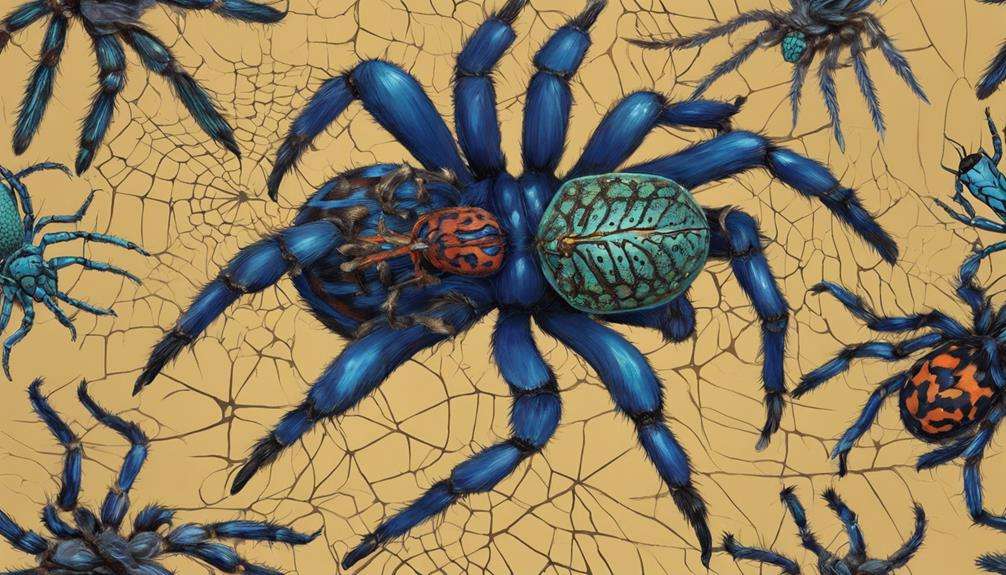
Rare metallic tarantula species, such as the Gooty sapphire ornamental tarantula, are known for their vibrant blue coloration and unique markings. These tarantulas stand out for their exceptional beauty and are highly coveted among enthusiasts for their striking appearance. Here are some fascinating facts about rare metallic tarantulas:
- The metallic sheen on their exoskeleton gives them a captivating appearance that sets them apart from other tarantula species.
- Gooty sapphire ornamental tarantulas originate from India, adding to their allure as a prized addition to any collection.
- Their limited availability due to being native to specific regions contributes to their desirability among exotic pet collectors.
- Despite their rarity, these tarantulas are sought after not only for their stunning looks but also for their fascinating behaviors, making them a favorite choice for those seeking a unique and captivating pet experience.
Unusual Transparent Tarantula Species
Transparent tarantula species, such as the Phlogiellus baeri, boast a remarkable feature – their see-through exoskeletons reveal the intricate details of their internal structure.
These tarantulas, originating from Southeast Asia, offer a captivating glimpse into their biology due to the absence of pigmentation in their outer covering.
Observing their transparent bodies in motion and during hunting activities can provide a visually stunning and educational experience.
Transparent Tarantula Anatomy
With a unique see-through exoskeleton revealing internal organs, certain tarantula species like the 'glass frog' tarantula (Sericopelma sp. 'boquete') offer a fascinating look into their intricate anatomy. These transparent tarantulas captivate enthusiasts with their mesmerizing features:
- The thin exoskeleton of these tarantulas, coupled with the absence of pigmentation, creates the illusion of transparency.
- Observing their internal structure unveils digestive organs, muscles, and even pulsating hearts.
- Their semi-translucent bodies provide a rare insight into the intricate design of arachnid anatomy.
- Transparent tarantulas stand out as unique specimens that showcase the beauty and complexity of nature's creations.
Care for See-Through Spiders
Care for See-Through Spiders involves creating a warm and humid environment, providing suitable burrowing substrate, and offering small prey items like fruit flies or pinhead crickets. See-Through Spiders, such as the Cyriocosmus elegans, require a consistent temperature range between 75-85°F and a humidity level of around 70-80%.
It's crucial to use a substrate that allows for burrowing, such as coconut fiber or peat moss. These transparent tarantulas are delicate, so handling should be kept to a minimum to prevent injuries.
Feeding adult See-Through Spiders once a week with small insects like fruit flies or pinhead crickets is sufficient. Regularly clean their enclosure to maintain a healthy environment for these visually stunning creatures.
Unique Transparent Behaviors
Observing unique transparent behaviors in certain tarantula species can offer a captivating glimpse into their internal workings and fascinating movements. The Knee Tarantula, known for its semi-translucent exoskeleton, showcases remarkable characteristics that intrigue enthusiasts and researchers alike.
Here are four fascinating aspects of the Knee Tarantula's transparent behaviors:
- Visible Organs: The thin cuticle of the Knee Tarantula allows observers to see its internal organs, providing a rare insight into its anatomy.
- Light Passage: Due to its transparent exoskeleton, light passes through, revealing the intricate movements and actions of this species.
- Internal Processes: By observing these transparent tarantulas, one can witness the inner processes that are typically concealed, shedding light on their behavior.
- Anatomical Insights: The transparency of the Knee Tarantula enables a unique opportunity to study its anatomy in real-time, offering valuable scientific insights.
Exquisite Multicolored Tarantulas
Exquisite multicolored tarantulas, such as the Gooty Sapphire Ornamental Tarantula, display stunning blue hues that captivate enthusiasts and collectors alike. The Gooty Sapphire Ornamental Tarantula, native to India, is renowned for its vibrant blue legs and metallic blue carapace.
Another sought-after species, the Cobalt Blue Tarantula, exhibits a mesmerizing metallic blue coloration that shimmers under light, adding to its allure.
For those attracted to striking contrasts, the Mexican Redknee Tarantula is a popular choice with its velvety black body adorned with bright red-orange knees.
If size is a consideration, the Goliath Bird Eating Tarantula stands out as one of the largest tarantula species, known for its impressive leg span and robust build.
Additionally, the Socotra Island Blue Baboon Tarantula offers a rare treat with its unique blue coloration, making it a prized specimen among tarantula enthusiasts seeking a distinctive addition to their collections.
Frequently Asked Questions
What Is the Most Expensive Pet Tarantula?
When caring for tarantulas, remember to provide a suitable habitat, proper nutrition, and a stress-free environment. The most expensive pet tarantula is the Borneo Neon Blue Leg Tarantula, valued at $149.99 due to its rarity and stunning appearance.
What Tarantula Can You Keep as a Pet?
When keeping a tarantula as a pet, ensure proper care by maintaining the right habitat setup, temperature, and humidity levels. Feeding on insects like crickets, tarantulas, whether docile or defensive species, make fascinating low-maintenance companions.
What's the Best Tarantula to Own?
For those interested in tarantula care, the Chilean Rose Hair Tarantula is a great choice for beginners. Its docile nature and low-maintenance requirements make it a perfect introduction to the world of tarantula keeping.
Can You Buy a Giant Tarantula?
You can purchase a giant tarantula, but be prepared for its unique care needs. Tarantula care involves providing spacious enclosures, a diet of insects, and a suitable environment. Remember, these gentle giants can live for years with proper care.
Conclusion
As you explore the vast array of exotic pet tarantula species available for purchase, remember that each one is like a unique gem in a treasure trove of arachnid wonders.
Just like a precious jewel, these creatures shine with their own distinct colors and characteristics, adding a touch of brilliance to your collection.
Embrace the beauty and diversity of these tarantulas, for they're truly nature's living jewels waiting to be admired.
